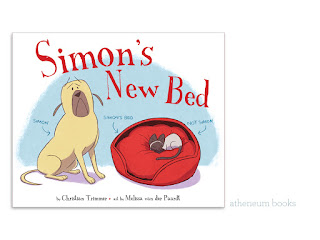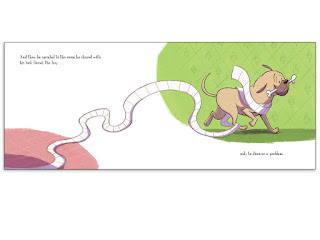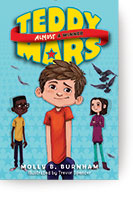new posts in all blogs
Viewing Blog: The Official SCBWI 10th Annual New York Conference Blog, Most Recent at Top
Results 26 - 50 of 1,119

ALICE POPE BLOGS LIVE FROM THE CONVENTION FLOOR AT THE HYATT GRAND CENTRAL, JANUARY 30-FEBRUARY 1
Statistics for The Official SCBWI 10th Annual New York Conference Blog
Number of Readers that added this blog to their MyJacketFlap: 11
John Parra is asked what he thinks makes a good picture book:
"When I feel like I get to a magical sweet spot in the [sketch] work that I can translate into the [final art] work... when I can feel like something magical is happening... that's what I'm looking for personally and professionally, even before an audience sees it.
Not everything you do will work or be interpreted by an audience they way you wished it would, but when you do get positive responses, you know it's good."
Susan Rich is asked the same question, and she says she asks herself three questions (which she says are stolen from The Horn Book) when reading the picture book:
"The picture book presents a
what if..."
A
then what that follows well from that
what if...
And then you can step back and say
so what.""We expect picture books to be read a gazillion times, it has to stand up to weary parents and antsy toddlers over and over..."
Susan also addresses what makes a commercially successful book to her:
"... I hope they are paving the way for me to publish more books by those creators, I'm looking for sales and critical acclaim, that it connects with some demographic in an important way and that we can build on that with more books from those creators.
Curricular or seasonal hooks can make your books easier to
get BUT I would never recommend starting from there. You can think about that at the query or later at the marketing level."
John says to follow your own voice, and don't worry about commercial vs. personal work, make it personal. Make it unique to your voice, and that's what's going to define you in your career. Be the first-rate you and not a third-rate Jon Klassen.
Susan says the best picture book texts have room for an illustrator to bring it to life, but also are manuscripts meaty enough to provide pacing and carry through with a full, narrative story, which is why poetry is not always a natural fit for picture books even if it's a completely beautiful and lyrical poem.
Laurent asks them about books they loved as kids:
John mentions
Virginia Lee Burton's LIFE STORY.
Susan Rich loved
C D B! by William Steig (link only goes to the colorized version :( )
Neal Shusterman is the New York Times best-selling author of the National Book Award-winning CHALLENGER DEEP, which was a Cooperative Children's Book center choice, a YALSA Popular Paperbacks for Young Adults pick, and on twelve state lists; THE SCHWA WAS HERE; and the Unwind dystology, among many other books.The first story Neal ever remembers writing was in third grade, a Halloween story that he received a D- on.
When he was 14, JAWS came out. He wanted to be Steven Spielberg with Peter Benchley. Books that were influential to him as a kid:
The Lord of the Rings, Lord of the Flies, The Shining. Neal wrote a book in high school that his teacher sent to a contest. He didn't win, but his teacher saw enough potential to send it in.
After graduating high school is when Neal really got into telling stories. As a camp counselor he was able to tell stories to quiet kids at night. First he started with movies he'd seen, but then he made up his own. When he went to college that year, he wrote the story that was popular with the kids that summer. He even sent it out to publishes (at 19). Every single publisher rejected it. Neal says for good reason. It was awful.
The next summer he had another story the campers loved. Neal did the same thing when returning back to college. He wrote the story and this one got him an agent. Unfortunately, his agent couldn't sell it. The story was not ready.
Ten years later he looked at the story again and knew what he needed to do. The same story, but all new words. This one was published.
His next book also received many rejection. Neal put it away and came back to it many years later and was able to rework it. It too sold.
When writing you have to do what works for you.
Be a well-rounded writer. Don't just focus on your strengths, focus on your weakness. If there is something you know that you need to do better, focus on it.

There's no such thing as writers block. Writers block is writing. A lot of times writing is like banging your head against the wall. If you call it writers block, it gives you permission to walk away. You have to work your way through it. It's part of the process.
Don't get stuck on just one book.
Be sure to get feedback from people who will be honest with you, especially other writers.
"Your work is never good enough, no matter how much you've been published." What's great as a writer is that you're always growing. Let yourself grow. On your next book, always asks what you can do better.
Why do we write? It's all about the reader. Deep down we all have something to say.
The first half of always awesome Lauren Rille of Simon & Schuster's afternoon session went over Bigger Picture Stuff for getting your picture book sketches and layout in good, overall shape before you move on to final art. But here are a few Smaller Picture Stuff details from the second half of her talk:
Once global pacing, tone, palette, etc., are established in your story art,
then you can go through and focus on all of those big picture things again, but page by page.
Simon's New Bed by
Christian Trimmer and illustrated by
Melissa van der Paardt has a fantastic example of how you can push POV/perspective in just one spread to completely change the entire emotional tone of the story:
Lauren shares the initial sketch of the scene where dog Simon comes into the room ready to use his new dog bed for the first time... And cat Miss Adora Belle...
The editorial team likes this sketch very much, but they ask Melissa to push the drawing even farther, to visually interrupt what had been a light and breezy, happy day of anticipation for Simon in these two earlier spreads:
And "stop the music" as Lauren says in the spread in question. And Melissa comes back with this:
Environment is the same, characters are the same, but look at all you can achieve with just a shift in camera angle!
And even with the POV change, the editorial team wants things to go one step further. Since this scene is the big shifting moment in the story's emotional arc so far, changing up the lighting and palette compared to the earlier spread will help underscore the change in the story's tone even more.
So good!
Thanks to Lauren and S&S for letting us use these images from her actual slides!
 Barney Saltzberg is a writer/illustrator and musician. He has written and illustrated close to fifty books for children, including the best-selling Feel and Touch series, which has over one million copies in print.
Barney Saltzberg is a writer/illustrator and musician. He has written and illustrated close to fifty books for children, including the best-selling Feel and Touch series, which has over one million copies in print.
What is a successful picture book (professionally and personally)?
Barney believes the rhythm of a page turn is so important. It's like music. Also the element of surprise. He wants to write a book that resonates every time.
Picture books are often placed in different categories whether more commercial sales or school and library. What considerations do you make when writing your books?
Barney says he doesn't think about that when he writes the books that I write and the marketing department and schools find where it fits.
On ways you get feedback on your work:
You have to be careful of who you share your work to and at which stage. While Barney did have a critiques earlier in his career, he now has authors/illustrators that he turns to for feedback when needed.
Barney tries not to go into the book store a lot. There are times he see another book and thinks, Wow, I wish I wrote that. As writers, we're trying to find our voice but if we compare ourselves with others, it's going to be a problem.

"We live in a world where Toys R Us has a girl aisle and a boy aisle and it drives me nuts."
Barney's next book is called WOULD YOU RATHER BE A PRINCESS OR A DRAGON? Barney's answer is that you can be both. Barney thinks parents will have some issues with this one.
Hey, all...can't wait for this one!
Favorite picture book childhood:
ARE YOU MY MOTHER? by P.D. Eastman
"I remember thinking it was hilarious when I was a kid."
Barney says there's a sense of humor and a sense of angst in the story, and the book works on so many levels. As a kid it appealed to his elevated sense of humor, that he as a kid got this inside joke. Having been lost as a child, there's a sense of wanting to find out what happens.
Final thought:
When getting feedback that Barney doesn't think works for him, he always takes the opportunity to sleep on it first before reacting and making a decision about it.
Don't wait for inspiration, make yourself go to work every day.
Jessixa Bagley and Don Tate took part in our panel on picture books. Jessixa is the Golden Kite winner for picture book texts, and Don has won numerous awards for his critically acclaimed texts and illustrations.
What makes a picture book successful? There's a sense of completion to it,
Jessixa said. It doesn't assume that the reader has knowledge about the subject. There's nothing left hanging. It's like an amuse bouche, a perfect bite. She's also drawn to books with a really deep meaning—a meaning that can be joyful too.
Don loves it when people can flip through his book and know the story by the pictures. He loves making emotional connection with readers. We connect with our readers through emotions. Page turns help guide readers from left to right through the story. "I like it when the illustrator has really done their job ... and you want to linger and live in that space for a while."
When it comes to developing stories for markets Don doesn't illustrate books differently on whether they're commercial or more for libraries. Don loves to illustrate books about little-known historical figures, which typically puts his books into the school/library market. This lets him do more school visits.
Jessixa also doesn't think about making books directly for markets, and thinks that books with emotional content can be really useful in school markets.
What collaborations help? Don is in several critique groups. They help him make his manuscripts stronger for agents.
Jessixa says you should treat your work like a baby egg. Nurture it until it gets a little more solid, and then you can share it. You won't be as hurt by the feedback. It won't be as bruising. It will be able to hatch. "We've all had the experience where you work on something really hard and you show it to someone and they don't respond to it, and you're gutted."
Advice: Don: Be sure to keep your stories child-focused. It's important to engage a child by beginning in childhood. Children like to see themselves represented on the first page of a book. He's not a fan of labeling books by gender. Sometimes, books appeal more to boy than to girls. But you don't need to labels. "Let the readers find them where they will."
Jessixa wasn't a girly girl. She wasn't a tomboy. She was just herself, so she gravitated toward identity-neutral things. There is universality to her work that she wants to extend. "I have a hard time with the fact that there are pink LEGOs and those are the girl LEGOs."
"Allowing the space to have things appeal to more people, whether it's gender or diversity, is going to make us all a lot stronger."
.jpeg?picon=2287)
By: Lee Wind, M.Ed.,
on 7/30/2016
Blog:
The Official SCBWI 10th Annual New York Conference Blog
(
Login to Add to MyJacketFlap)
JacketFlap tags:
#LA16SCBWI,
picture books,
Don Tate,
john parra,
Laurent Linn,
Barney Saltzberg,
Susan Rich,
jessixa bagley,
Add a tag
Moderated by Laurent Linn (standing), the panelists, left to right, are: author/illustrator Jessixa Bagley, illustrator John Parra, editor Susan Rich, author/illustrator Barney Saltzberg, and author/illustrator Don Tate.
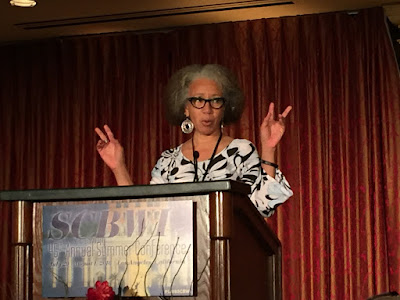 |
| Carole Boston Weatherford giving her keynote |
Carole Boston Weatherford is an award-winning, New York Times best-selling author of over forty books, mostly for young people. Her books have won two NAACP Image Awards, two Caldecott Honors, and a Coretta Scott King Award. Her best-known titles include Moses: When Harriet Tubman Led Her People to Freedom; Voice of Freedom: Fannie Lou Hamer, Spirit of the Civil Rights Movement; Freedom on the Menu: The Greensboro Sit-ins; and Gordon Parks: How the Photographer Captured Black and White America. Her latest release is You Can Fly: The Tuskegee Airmen, a collaboration with her son, debut illustrator Jeffery Weatherford. She is an English professor at Fayetteville State University in North Carolina. Visit https://cbweatherford.com.
Lin's introduction includes calling Carole "a national treasure… She's an historian, she's a story-teller."
Carole jumped right in to share that:
"The premise may be the most important 25 words you write."
Whether you call it an elevator pitch, log line, or T.V. guide pitch, the aim is the same - to distill your storyline to one easily understood sentence that conveys what the protagonist has to overcome. The premise is a promise your manuscript will deliver on.
Brief. Provokative. Contains character, conflict, and a hook that you and your readers can be passionate about, and reveals something about the larger world.
She shared premises of different children's books (picture books through YA, fiction and nonfiction) to see if we, the audience, can guess the book - showing us what good premises accomplish.
Carole then told us about the organic way she came up with the premises for some of her books, how those premises shifted and developed and coalesced. Books she spoke about included:
Freedom on the MenuA Negro League ScrapbookAnd
MosesWe heard poems, and stories, and as Carole's whole talk proved,
"There is power in knowing your premise."
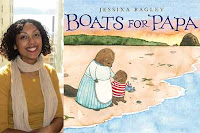 Jessica Bagley and Neal Porter’s breakout session rolled out in perfect sync. Bagley spoke about the process of creating her debut picture “Boats for Papa,” while Porter injected tidbits of his picture book-making philosophies along the way.
Jessica Bagley and Neal Porter’s breakout session rolled out in perfect sync. Bagley spoke about the process of creating her debut picture “Boats for Papa,” while Porter injected tidbits of his picture book-making philosophies along the way.
Bagley spoke about her early years as a picture book author-illustrator, feeling utterly alone and isolated. She made a lot of mistakes along the way, she admitted, thinking she could figure this business out on her own. Finally, she joined the SCBWI where her career began to make a change. Since then, she has soared!
 One morning while in bed, during the time when she wrote “Boats for Papa,” Bagley experienced an Oprah-like “Ah-ha” moment. She realized that her little picture book was actually the story of her own life—proving that real life shapes great stories.
One morning while in bed, during the time when she wrote “Boats for Papa,” Bagley experienced an Oprah-like “Ah-ha” moment. She realized that her little picture book was actually the story of her own life—proving that real life shapes great stories.
Bagley went on to discuss her process of making picture books, from thumbnail sketches to final art. Neal Porter injected his thoughts along the way. An important one:
—Have a sense of who you’d like to have publish your books. Do your research. It is important to know Porters list, the kinds of books he publishes. Be sure you're agent knows his list, too, as he often receives manuscripts from agents that aren’t a good fit for his list.
 In her mini keynote, Nancy Castaldo spoke a lot about presenting to children and sharing what inspires her stories: childhood experiences and present passions.
In her mini keynote, Nancy Castaldo spoke a lot about presenting to children and sharing what inspires her stories: childhood experiences and present passions.
She also spoke about the process of research for writing “Sniffer Dogs: How Dogs (and their Noses) Save the World," which also included a lot of talk about, um, dogs sniffing poop! Who’da thought!
When talking about her author journey, she spoke about the rocky rejection path that sometimes lead writers to feeling insecure. But take heart, she also reminded us that celebrated authors like Jane Yolen still receive rejection. “We are not alone, rejection happens to all of us,” she said.
Castaldo shared many inspiring quotes, including this one from Junot Diaz: “A writer is not a writer because she writes well and easily, because she has amazing talent, or because everything she does is golden. A writer is a writer because, even when there is no hope, even when nothing you do shows any sign of promise, you keep writing anyway.”
So, how does the path to publication end? Well, you had to be there.
Tina Wexler is a literary agent ICM Partners.
Tina shares tips that will help us find success.
You need a strong story idea. An idea that will sustain you through the drafting and writing process. Do you have unfinished manuscripts in a drawer? It might be because it didn't have enough to sustain you.
Your manuscript needs to be researched. Read 3 other recently published books in your same genre and age range. Look up the things you don't know. Not all of your research will make it in, but it will inform your story.
Your manuscript needs to be revised. No one gets it right the first time.
Your manuscript needs a strong voice.
Your manuscript needs a vacation. Set it aside. Work on something else. Take time away so you can come back with fresh eyes. When you return to it, revise it again.
Your manuscript needs to be loved. Finishing is not a reason to send it out on submission. You need to love it. It needs to be ready.
Great reads from the session:
 Marie Lu is author of the Legends and the Young Elites trilogies.
Marie Lu is author of the Legends and the Young Elites trilogies.
Her books have "interesting, complex plots that never settle for easy answers," Lin said as she introduced Marie, an extraordinarily successful writer.
SCBWI was one of the first conferences Marie ever heard about as an aspiring writer. LEGENDS is set in a futuristic LA and it's about a boy who's the most wanted criminal and a girl who's the most gifted hunter of criminals.
"I'm a very happy person. My books do not reflect this," she joked.
Marie always liked writing, but didn't know you could do it for a living. She was born in Beijing, and was five years old during the Tiananmen Square massacre. Her family came to the states and settled in New Orleans. The family knew no English. Her mom wanted to go out and see what typical American families do. So they set out—and it was Mardi Gras.
"I have this memory of standing there in this crazy street where people were throwing beads at you for no reason." She didn't know what had just happened—"but I liked it."
She started writing to learn English. In kindergarten, she had to look up five English words every day and put them into sentences. "I eventually realized I liked the practice of putting words into stories."
She became a voracious reader. She loved Brian Jacques's Redwall Series, Harry Potter, and Tolkien. She had a writing desk in her room, and she made the space where the chair went into a library, which she enclosed with a curtain and illuminated with a flashlight.
She also loved to draw and would put a paper up to the screen a trace a frame of a Disney movie. "I eventually figured out how to draw on my own." Her childhood was drawing and reading and playing games. "I loved every second of it."
She wrote her first novel at 14, and she thought it was "amazing." It involved a chosen one on the quest with dwarves and elves "for a shiny thing." She submitted to 100 agents, but didn't get any bites.
She used to set her alarm clock during high school for 2 AM, and she'd write two hours a night. Her second manuscript, written when she was 16 or 17, was "a little bit less bad." It got her an agent, but many more rejections. She would draw and write in her spare time, and before her school work, but her parents worried she wouldn't be able to support herself. So she studied political science in college. She kept submitting books and kept getting rejections, and parted ways with her agent.
She applied for a Disney internship. Her parents: "Our basement is here for you. You go and do what you need to do to make yourself happy." She got the gig and worked there for two years. "It was absolutely a life-changing experience. This was the first time in my life I had been surrounded by fellow creative people."
"Once I started working in video games, I started writing again." She got a new agent, Kristin Nelson, and her fourth novel went out on submissions. She got a lot of rejections. By the time her fifth novel, LEGEND sold, she'd been rejected 500 times. "Rejection eventually becomes a piece of paper. Put it on the pile. We'll build a fort out of it."
Because rejection didn't bother her as much, she could concentrate and write LEGEND.
"Every writer succeeds at their own pace. It took me 12 years and four unpublished manuscripts... There are no guarantees in this business."
She gave us some terrific writing advice: about the importance of hard work, about learning to take criticism, and about the importance of not comparing ourselves to others.
"Be brave and listen," she told us. "None of us know everything. None of us is always right. We can always learn more." She feels she made mistakes with the relationship of a couple in LEGEND. She didn't know at the time, and she learned to see her failure there because she listened. "No one enjoys being called out," she said. But our intentions don't matter if they don't come across on the page.
"We are all in this together. The journey to publication is not always fair. It takes all of us to lift up those voices that struggle to be heard."
Follow Marie on Twitter.
Start reading THE YOUNG ELITES
Marie Lu on Tumblr
Canadian Treasure Jon Klassen, author/illustrator of award-winning picture books as well as the illustrator of many great chapter books, is here! He is quick to clarify he's not going to talk about how to find your style:
How you work on something isn't the same thing as your 'style':
"Style is mysterious and shouldn't be opened, at least not by you...
Don't think about it.
Take care of the machine that makes it, so you can get better at making your work..."
Don't Think About Yourself At All
Jon recommends treating the project as something outside yourself.
Some of his favorite artists subscribe to this particular work ethic:
Agnes Martin, who says "The worst thing you can think about when you're working is yourself."
David Bowie, when asked by a reporter how cool it was to be a rockstar with a crazy successful album, said it's not David Bowie who's successful, it's the character Ziggy Stardust! Jon says Bowie needed a character first to get into his work, which let him not have to ask what would "I" do, but what would Ziggy or the Thin White Duke do.
Artist/weaver Anni Albers has this quote Jon loves:
Another great idea from Jon:
Treat your brain the way Pixar treated computer technology, do your best work with the resources you have at that time.
When first starting out, Pixar had hundreds of ideas for stories, but computer animation made everything look stilted and plastic and non-human. Instead of fighting their technology, Pixar embraced the limitations by animating things that were naturally plastic-y and clunky:
Similarly, Sendak's dummy for WHERE THE WILD HORSES ARE had tons of horse drawings in it, but Maurice hated drawing horses! So his legendary editor Ursula Nordstrom asked him what he
would enjoy drawing and Maurice said he didn't know, but he liked drawing THINGS...
Jon describes how he went from being a grumpy animator who only wanted to draw rocks and chairs, to a picture book author/illustrator who enjoys creating characters outside of himself who can 'write' their own lines. Jon mentions he felt like his voice as a narrator is similar to that of a drunk P.D. Eastman, but when he thinks about the characters acting in a play—spouting their own lines, not his—he's able to take himself out of the equation and make something good.
You are not in control of almost any part of this process, Jon says, except for keeping out what you don't want in a project, chipping all that away. A book is like a child, you can shepherd it along, but it may wander off without you somewhere amazing, and that's a great thing.
Always a highlight of the conference, this gathering of people interested in including LGBTQ characters and themes in our work for children and teens was a warm, safe space that brought up some powerful issues and generated enormous good-will. We sat in an large oval and took the time for each person to introduce themselves and share what they were working on, and, if they had one, ask a question of our 'brain trust.'
Faculty guests included Arthur A. Levine, Bruce Coville, Neal Porter, Emma Dryden, Ellen Hopkins, and Laurent Linn.
Jessixa Bagley is by far Seattle's favorite Jessixa, and she'll be yours, too. BOATS FOR PAPA is a beautiful, lyrical book and her fellow Seattleites are thrilled that she/it have received this fantastic award.
In her acceptance speech, Jessixa thanks SCBWI, her lovely agent,
Alexandra Penfold, and her stellar editor,
Neal Porter. Jessixa got teary as she thanked her artist/author husband,
Aaron Bagley, who she says helped her find her voice.
Jessixa says, upon receiving the call from SCBWI that she'd won the Golden Kite for Picture Book Text, that her Illustrator Brain thought,
"Text!? Did my illustrations suck?"But luckily her Author Brain piped up and said,
"Hey! This is great!"
Jessixa's always felt much more comfortable calling herself an artist, "Calling myself an author... Author almost seemed like a taboo word... It seems like a dream now to be up on this stage. I went from thinking I'd never be published, to being here. Writing picture books is the hardest thing I've ever done, but also the most rewarding."
I love Jessixa's inspiring, concluding thoughts to us: She says if we haven't found our voice yet, to not be scared, it's there. It might be really quiet, but the more you write, the louder it will become.
Congratulations, Jessixa!!!

#LA16SCBWI nonfiction aficionados gathered in the ornately walled Athenian room to socialize, network, and talk trade. And this is just a few of them–more people flowed in after the photo was taken! What was the nitty-gritty? You'll just have to be there next year to find out.
 |
| Neal accepting his Golden Kite Award |
Neal Shusterman is the New York Times best-selling author of the National Book Award-winning Challenger Deep; Bruiser, which was a Cooperative Children’s Book Center choice, a YALSA Popular Paperbacks for Young Adults pick, and on twelve state lists; The Schwa Was Here; and the Unwind dystology, among many other books. He lives in California with his four children. Visit:
www.storyman.comNeal's "Challenger Deep" is the winner of this year's 2016 Golden Kite Award for Fiction.
Neal tells us about where "Challenger Deep" came from. About his son's mental illness and struggle and ultimately rising above it. Not a story about his son, but inspired by thing things his son went through. He took the artwork his son had created while he was in the emotional depths, the mental depths, and built a story from that.
"Challenger Deep frightened me. ...I wanted it to be emotionally honest," and something that his son would be proud of. It took him four years to write. How he was so nervous about his editor's response, and how gratified he was by her response that it was "a masterpiece." And then he gets a great laugh when he says that praise was followed by a ten-page editorial letter!
"Challenger Deep is a call to action. To talk openly about mental illness."
This year's Golden Kite Award for Middle Grade/Young Readers is Kate Hannigan for THE DETECTIVE'S ASSISTANT.
"How many of you have received rejection notices?" Kate asks.
Hands shoot in the air.
Kate shares her 65 feet of rejection. With help, she rolls it out like a red carpet!
Look at that. That's how you get applause for rejection.
Kate share that in 2004, a year into being involved with SCBWI, she started receiving notices about winning awards and receiving invitations to speak at school, when she hadn't yet published. People were confusing her, Kate Hannigan, with Katherine Hannigan. THE DETECTIVE'S ASSISTANT also came out within days of Katherine's latest book. Kate found she had to make her own mark and break through with her own voice.
"I wrote and wrote like a pack of wolves was at my heels," Kate says.
Kate describes writing the book as "a giddy wind in a hair thrill."
Margarita Engle accepted the Golden Kite Award for nonfiction for her book, “Enchanted Air: Two Cultures, Two Wings: A Memoir,” (Atheneum).
She spoke about the challenges of writing a memoir, noting that memories swirl in time. “There is not a website for looking up your childhood,” she said
Margarita wrote “Enchanted Air” to offer hope to children of immigrants, and for her hope for better relations between the United States and Cuba.
Her plea for peace, she said, became a song of thanks when the book published on the same day the United States opened its doors to Cuba.
Poignant.

John Para accepted the Golden Kite Award for picture book illustration for “Marvelous Cornelius,” written by Phil Bildner (Chronicle Books)
He spoke about working as an illustrator for twenty-plus years without having any idea about the world of children’s books—this “huge and wonderful community of writers and illustrators.”
John recalled how art called him since early childhood, drawing pictures in his bedroom for hours at a time. It was a calling that got stronger as he grew, a calling that led him to a career in illustration.
He spoke energetically about the story of Marvelous Cornelius, leading the audience in an interactive call and response: “Whooo-whooo-whooo! Rat-a-tat-tat!
John ended his speech with a Dr. King quote: “If a man is called to be a streetsweeper, he should sweep streets even as Michelangelo painted, or Beethoven composed music, or Shakespeare wrote poetry. He should sweep streets so well that all the hosts of heaven and earth will pause to say, here lived a great streetsweeper who did his job well.”
Hootie-hoo!

 The Sid Fleischman Humor Award this year goes to the wonderful Molly Burnham, who wrote TEDDY MARS: ALMOST A WORLD RECORD BREAKER.
The Sid Fleischman Humor Award this year goes to the wonderful Molly Burnham, who wrote TEDDY MARS: ALMOST A WORLD RECORD BREAKER.
The award, named for the beloved writer Sid Fleischman, is given to the year's best funny book. Sid was one of the founding members of the SCBWI. Lisa Yee won the award the first time it was given, and she presented the honor to Molly, a debut novelist.
"Are you freaking out? If you're not, there's something wrong with you," Lisa said to Molly. "There are 1,000 people staring at you. THAT'S 2,000 EYEBALLS."
TEDDY MARS is about boy obsessed with breaking world records. He'll try anything to reach his goal. "Funny, charming, and with its share of pigeon-poop jokes, this is a must-read for anyone who's ever felt out of place."
"When I found out I won this award, I immediately felt I wasn't funny any more," Molly said. (Everyone laughed immediately, proving the Molly is bonkers.)
She cried when she found out she won the Sid Fleischman award. "It's been a faraway dream that I would someday be worthy of this award. This dream ... started when I was a little kid. It means so much, and I am—to borrow a word from Road Dahl—ridonkuloulsly blissful."
Florida RA Linda Bernfeld!
As Lin said of Linda, "She's launched more careers... than you could count."
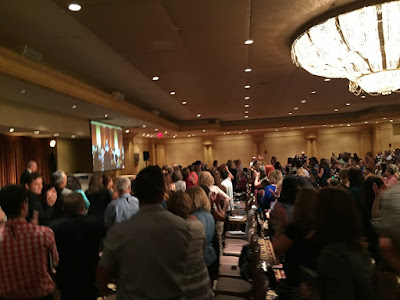 |
| The standing ovation for Linda |
Congratulations, Linda!
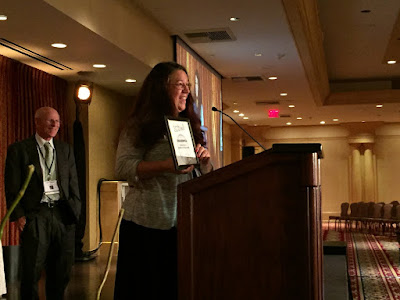 |
| A well-deserved honor |
On a personal note, I'm so delighted for Linda, who gets the crown after me…
Okay, while it doesn't come with a Tiara, winning SCBWI Member of the Year is a huge honor, and I'm so happy for you -- Congratulations!
It's an open call. Are you an illustrator attending #LA16SCBWI?
If you'd like to share a photo of your conference notes/sketches, you can leave a link here in comments, or tag your image on either twitter or instagram with #LA16SCBWI.
We can't wait to see - and share - what inspires you, and how you express it!
Saho Fujii shares some details about the picture book making process for illustrators. Here are some highlights:
DEADLINES:
Wild fact: She has two books coming out this fall that have been in production for five and ten years! She says these are exceptions, most books take a year or two.
At Little Brown, there are two book seasons, and each have pretty standard deadlines for art.
Spring books: Sketches are due: 4/1 and final art is due 8/1
Spring books: Sketches are due: 10/1 and final art due 2/1 of following year...
These are standard schedule dates in the LB contract an illustrator receives!
I might have to lie down.
Changes to the schedule can be made, but an illustrator must tell their editor/art director production team as soon as possible if they need more time.
TRIM/PAPER/PAGES:
Trim size is chosen, as are paper types (dependent on book age range and category) and pagination lengths.
CONSISTENCY:
Saho is looking for character and setting consistency at the sketch stage to be sure those are consistent in the final art.
COLOR:
Even at the sketch stage when there may be no color, Saho is aware of potential issues, for example, when working on Jerry Pinkney’s TORTOISE AND THE HARE, Jerry had mentioned he wanted the story set in the dessert. But the art team expressed concern the pages would be monochromatic, and that the main characters would blend into the background too much. So Jerry added colorful props and accessories to the tortoise and hare, as well as colorful, extra cast members to help vary the palette more.
 Jennifer L. Holm is a New York Times best-selling author and recipient of three Newbery Honors.
Jennifer L. Holm is a New York Times best-selling author and recipient of three Newbery Honors.
Lin introduces one of her favorite authors, who excels with both novels and graphic novels (written with her brother Mathew).
When Jenni's ballerina dreams fell apart at a very young age, she decided she wanted to be writer.
Much of her writing has been inspired by her own family.
Jenni's dad was her inspiration for OUR ONLY MAY AMELIA after finding her great aunt's diary in her grandmother's attic.
But Jenni tells us, when you write a book about your dad's family, you did it wrong. You should have written one about your mom's first.
PENNY FROM HEAVEN was inspired by her mom's family.
Jenni's next book TURTLE IN PARADISE came out of writing PENNY FROM HEAVEN and was inspired by her son.
Jenni didn't want to forget her husband in all this inspiration. In BOSTON JANE, Jane falls in love with a sailor who has a scar on his cheek. This was the time she was falling in love with her husband.
Jenni circles back to her physician father, who always talked about science, as the inspiration for THE FOURTEENTH GOLDFISH.
SUNNY SIDE UP was inspired by her gramps, who is "still alive and kicking at 101."
FULL OF BEANS, Jenni's upcoming novel comes back to Key West (where TURTLE IN PARADISE is set) and it's a book her son asked her write.
Barney Saltzberg is an author/illustrator and musician, including the best-selling
Touch and Feel Kisses series.

"Creating a simple picture book isn't simple, it's complicated."
Barney mentions that if you don't know Peggy Rathmann, you should. She once told him it takes 3 minutes to read a picture book that takes 3 years to create.
Kids always ask, "Is this a hard job?" And Barney tells them that he used to have all his hair.
Picture books may be short but they are one of the most difficult to master. They are works of art.
Barney recommends Ann Whitford Paul's WRITING PICTURE BOOKS.
Two of Barney's former students share their journeys of the many years it has taken them to bring a picture book to life. For one, it's taken 6 years to create a 100 word picture book. Not simple, it's complicated.
View Next 25 Posts












